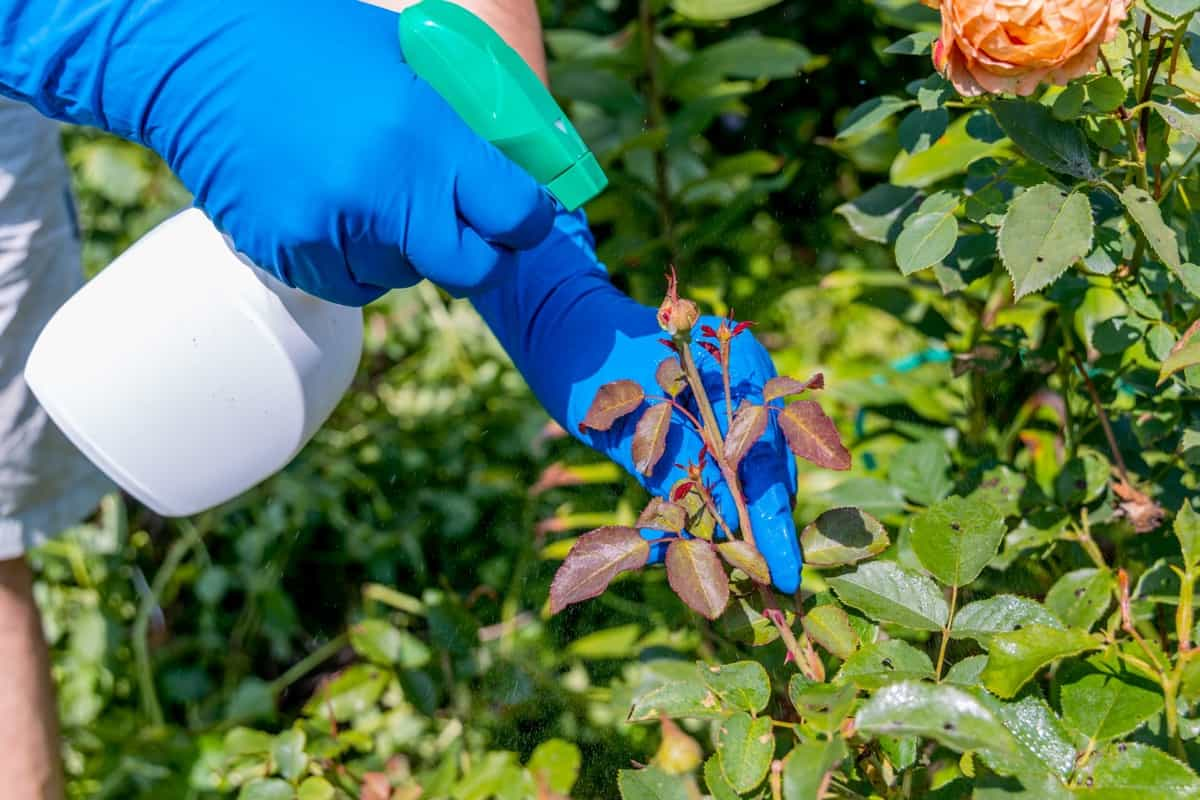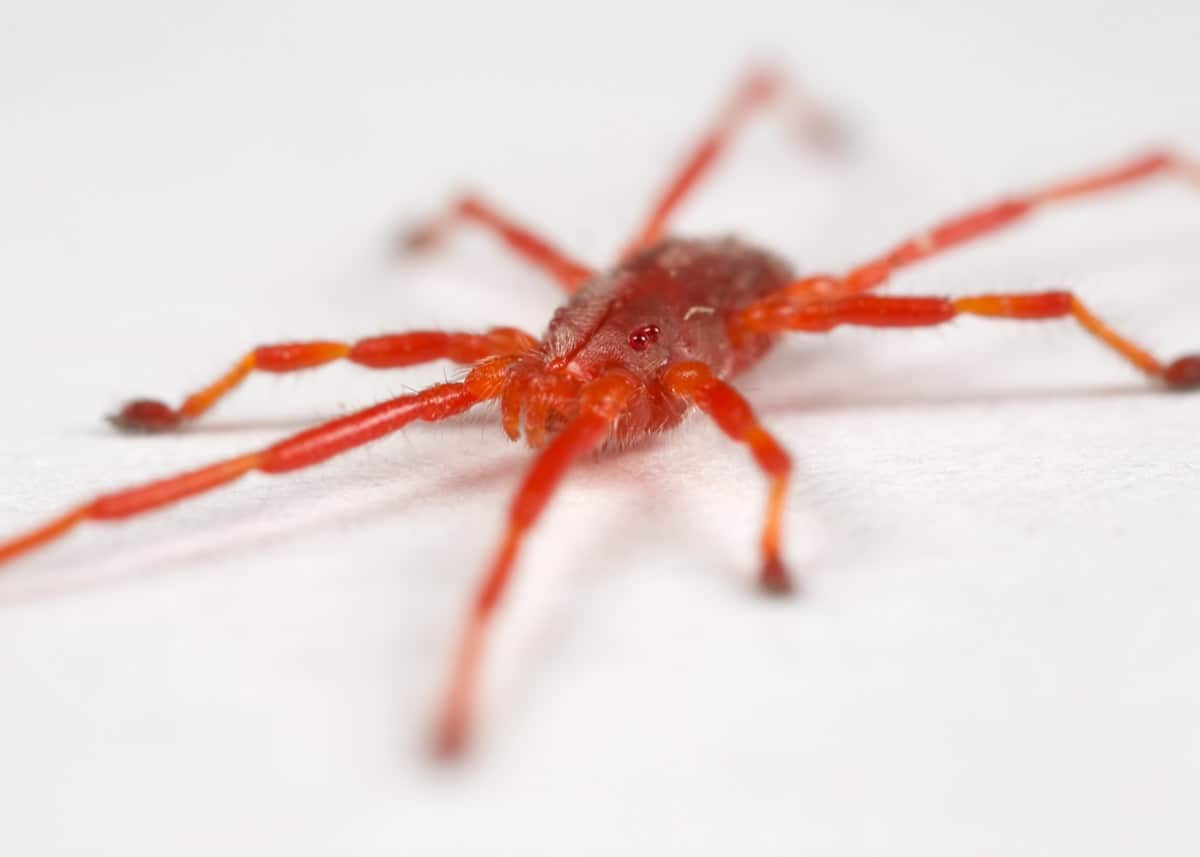The Rose Red Spider Mite, Tetranychus cinnabarinus, belonging to the Family Tetranychidae of the Order Acarina, is a tiny insect pest that causes significant yield losses and reduces the quality of crops worldwide. The high reproductive rate of the pest is one of the reasons why they are such a devastating pest for rose crops. Their small size and the ability to reproduce quickly make it difficult to control their populations once they infest a plant.

Effective management strategies are essential to minimize the impact of this pest on Rose production. To effectively manage this pest, it is necessary to understand its life cycle, its preferred habitats, and the best methods for controlling it. This article will provide an overview and discussion of the Rose Red Spider Mite Pest in Rose crops, including its symptoms, identification techniques, and control.
Rose Red Spider Mite Pest Management
Life Cycle of Rose Red Spider Mite Pest in Rose Crop
The life cycle of the Rose Red Spider Mite pest has four stages. They are egg, larva, nymph, and adult. The lifecycle of the rose red spider mite begins when the female mite lays about 50-100 spherical, transparent eggs on the underside of the leaves, which hatch in 2-3 days. The eggs are usually found in groups and can be easily overlooked due to their small size.
After hatching, the mites enter the larval stage, lasting about three days. They feed on the phloem sap of the leaves, causing yellowing and browning of the leaves. The larvae then molt into the protonymph stage. The protonymph stage lasts for about one day. The mites feed on the leaves and molt into the deutonymph stage. The deutonymph stage lasts for about three days.
They also continue to feed on the leaves and molt into the adult stage. The adult stage lasts about five days, and the mites are mature. The female mite lays eggs on the underside of the leaves, and the lifecycle continues. The entire lifecycle, from egg to adult, takes about two weeks and produces around 15 generations in a year, depending on the temperature and other environmental conditions.
Occurrence of Rose Red Spider Mite Pest in Rose Crop
- Location of Rose Red Spider Mite Pest: This pest infests Rose crops in India, Africa, Sri Lanka, China, Thailand, Vietnam, Indonesia, the United States, Mexico, Brazil, Colombia, Ecuador, the Philippines, and Australia.
- Host Range: The Rose Red Spider Mite pest infects crops like Roses, Beans, Cucumbers, Tomatoes, Strawberries, and Peaches.
Factors Favoring the Population Increase of Rose Red Spider Mite Pest in Rose Crop
- Temperature – The pest reproduces rapidly in warm, dry environments, with the ideal temperature range for the mites being between 20-30°C, and they are most active during summer.
- Low Humidity – The pest prefers low humidity, and high humidity can harm their survival.
- Limited Water Supply – Water-stressed plants are more susceptible to infestations, and it is not uncommon to find infestations in areas with limited access to water.
- Lack of Natural Predators – The pest can thrive without natural predators such as ladybugs and lacewings, which could help control its populations.
- Lack of Proper Sanitation – Poor sanitation practices in rose crops, such as leaving dead plant material or debris in the field, can provide breeding grounds for the pest.
- Overcrowding of Plants – Overcrowding plants can help the pest easily move from one plant to another, increasing the chances of infestation.
Identification of Rose Red Spider Mite Pest in Rose Crop
- Egg: The eggs are spherical, transparent, and barely visible to the naked eye.
- Larva: The larvae are six-legged and have a round body.
- Proto-nymph: The pest appears similar to the larval stage but with eight legs instead of six.
- Deuto-nymph: The pest appears similar to the adult stage but is smaller and lacks organs.
- Adult: The female mites are usually 0.5 mm long, whereas the males are smaller, about 0.3 mm long, and are reddish-brown.
Damage Symptoms of Rose Red Spider Mite Pest in Rose Crop
- The pest feeds on the sap of the lower side of the leaves, causing yellowing, browning, and, eventually, the death of the plant.
- The pest is covered with silk webs. They are named spider mites due to their spider-like appearance and behavior.
- The yellow spots can be seen clearly on the upper surface of the leaves, and they turn reddish-brown on feeding.
- In severe cases, the infested leaves dry, wither, wilt, and eventually drop. Flower production and plant growth are also severely affected.
In case you missed it: Rose Aphid Pest Management in Rose: Symptoms, Treatment, Chemical, Biological, and Organic Control

Percentage of Yield Loss in Roses Due to Rose Red Spider Mite Pest
- In India, the yield losses due to Rose Red Spider Mite pests are 50%. In Thailand, the percentage of yield loss is 25%. In Vietnam, the losses are 35%. In Sri Lanka, the losses are 30%. In Indonesia, the losses are 40%. In Africa, it is 20%. In the United States, it is 30%. In Mexico, it is 20-25%. In Brazil, it is 30%. In China, it is 20%.
- In Colombia, the losses are 25%. In Ecuador, it is 45%. In Australia, it is 40%. In the Philippines, the yield losses are 20%. The Economic Threshold Level (ETL) for the Rose Red Spider Mite pest is set at 10% infested leaves.
Cultural Control of Rose Red Spider Mite Pest in Rose Crop
- Sanitation – Keep the rose crop clean and free of debris. It is critical in preventing pest infestation.
- Pruning – Regular pruning of the plants, removal of dead leaves and debris, and weed management can help reduce the incidence of pest infestation.
- Irrigation – Proper irrigation can help maintain the vigor and health of rose plants, making them less susceptible to infestations.
- Fertilization – Proper fertilization with balanced nutrients can promote plant growth and vigor, making it more resistant to mite attacks.
- Crop Rotation – The pest prefers to feed on rose plants, and crop rotation can help reduce the population of the pest by depriving it of a food source.
Biological Control of Rose Red Spider Mite Pest in Rose Crop
- Predatory Mites – Predatory mites, such as Phytoseiulus persimilis, Neoseiulus californicus, and Amblyseius andersoni, feed on the pests and their eggs, reducing their population.
- Predatory Insects – Lady beetles, such as the Adalia bipunctata (two-spotted lady beetle), feed on the pest and their eggs, reducing their population.
- Parasitic Wasps – Parasitic wasps, such as Phytoseiulus longipes, lay their eggs inside the pest’s eggs; when the larvae hatch, they feed on the pest’s eggs, killing them.
- Entomopathogenic Fungi – Entomopathogenic fungi, such as Beauveria bassiana and Metarhizium anisopliae, infect and kill the pest.
- Entomopathogenic Nematodes – Entomopathogenic nematodes, such as Steinernema feltiae and Heterorhabditis bacteriophora, infect and kill pests in the soil.
Chemical Control of Rose Red Spider Mite Pest in Rose Crop
- Spray Insecticides on the crops like Flufenoxuron, Carbaryl, Milbemectin, Malathion, Bifenazate, Wettable Sulphur, and Dicofol on the foliage to control the pest.
- Acaricides – Spray Hexythiazox, Abamectin, Spiromesifen, and Fenpyroximate to control the insect pest.
Organic Control of Rose Red Spider Mite Pest in Rose Crop
- Plant extracts from neem, garlic, cinnamon, ginger, turmeric, hot pepper, and Rose can be applied to manage the infestation.
- Neem oil and Garlic extract disrupt the pest’s nervous system and its ability to feed and reproduce, ultimately killing them.
- Clove oil, Peppermint oil, and Eucalyptus oil disrupt the pest’s hormonal balance and inhibit its feeding and reproductive abilities.
- Mineral-based insecticides such as diatomaceous earth and kaolin clay can control pests by physically disrupting the pest’s cuticle and causing dehydration.
- Spinosad produced by the soil bacterium Saccharopolyspora spinosa should be sprayed on the leaves and stems of the plants to control the pest.
Preventive Measures for Control of Rose Red Spider Mite Pest in Rose Crop
- Regular Watering – Regular watering is essential to keep plants healthy and resistant to pests.
- Avoid Over-Fertilization – Over-fertilization can lead to lush growth, attracting the pest.
- Resistant Varieties – Planting healthy, resistant, or tolerant varieties can prevent pest incidence.
- Regular Monitoring – Monitor the crops regularly to identify pest infestation in the early stages to keep it under control.
- Sticky Traps – Use yellow sticky traps to monitor the pest’s activity and determine the control measures.
In case you missed it: Rose Red Scale Pest Management: Symptoms, Treatment, Chemical, Biological, and Organic Control

Conclusion
The Rose Red Spider Mite Pest, Tetranychus cinnabarinus, is a major pest that affects Rose crops worldwide, causing significant yield losses. Using IPM to manage the pest can help reduce resistance to chemical control methods and minimize the risk of pesticide residues in the environment and on the crop while effectively controlling the pest population.
- Natural Solutions for Pest Control in Flower Gardens
- Types of Fungicides Used in Agriculture
- Common Issues in the Fruit Development Stage of Pomegranate Farming
- Fruit Development Issues in Papaya: Easy Solutions and Treatment
- Soil-Borne Diseases and How to Protect Your Plants
- Practices to Prevent Disease Spread in the Garden
- From Wilted to Thriving: How to Treat Root Rot Naturally in Houseplants
- Natural Remedies to Cure Brown Spots on Fig Tree Leaves
- Natural Solutions for Poinsettia Problems: 100% Effective Remedies